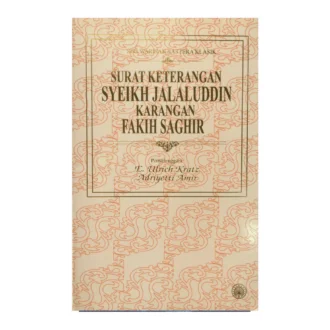Malay Historical Thought aims at the redevelopment of the Malay historical thought particularly its conceptual aspect as understood by the Malays from their classical historical texts. For the purpose of the study, three great books (Karya Agung) of Malay history, namely Hikayat Raja-raja Pasai, Sejarah Melayu or Malay Annals and Hikayat Merong Mahawangsa were selected to be the major sources from which the Malay historical thought could be unveiled and redeveloped.
Studies conducted by western scholars on the history of the Malays since the beginning of the European colonisation had resulted in a number of undesirable outcomes. The works resulted from these studies were detrimental to the worldviews of the Malays and it was through these works that the misconceptions on the Malay history mainly originated. The misconceptions rooted from two major factors. Firstly, the western biased views towards Malay history due to their pride over the superiority of their political power within the Malay region. Secondly, the rampant negative perceptions over the classical Malay historical texts. In order to counter their arguments and to reestablish a proper Malay concept of history, this study had suggested a reinvestigation on the Malay classical texts using a proper and appropriate method.
Generally, Malay Historical Thought employed a traditional historical and cosmological analysis method which is neither quantification nor psychohistory. Specifically, the philological and traditional cosmological methods were two major approaches utilized in order to unveil the concept of Malay history from the selected texts. In the philological method, the main concern is to study the external contents of the classical Malay historical texts. While in the traditional cosmological approach, the internal aspects of the texts were analyzed by utilizing the traditional cosmological and semantic approaches as practised by the scholars in this field. Modern historical approaches had indeed unable to explain most of these internal aspects of the contents, particularly regarding the mythological and legendary aspects.
Through these approaches, a remarkable finding showed that the Malays owned a very special concept of history. Even the most unhistorical aspects of the classical Malay historical texts were finally discovered to have embodied a number of significant historical values. Some suggestions and recommendations had been made for further studies in the future.
Preamble
Acknowledgements
List of Diagrams
List of Abbreviations
Arabic Transliteration Table
CHAPTER ONE: Introduction
CHAPTER TWO: Some Misconceptions
The Old View: The History of Colonial Powers
— The Portuguese and the History of Malay Archipelago
— The Dutch and the History of Malay Archipelago
— The British and the History of Malay Archipelago
The Emergence of a New View: the Study of Local Malay History
Misconceptions in the Study of Classical Malay Historical Texts
— Misconceptions Resulted from the Studies
— How Did the Misconceptions Emerge?
The Need for a Proper Malay Concept of History
CHAPTER THREE: From Pre-Historic to the Period of Islamization
Foundation of the Malay Historical Thought
Malay Historical Thought in Pre-historic Times
Hinduism and Buddhism in Early Malay Historical Thought
Islamization and Its Impact on the Malay Historical Thought
CHAPTER FOUR: The Selected Texts
Three Classical Texts of Malay History
— Hikayat Raja Pasai
—— Background of the Text
—— Manuscripts and Published Editions
—— Studies and Comments
—— The Essentials of the Contents
— Sejarah Melayu or Malay Annals
—— Background of the Text
—— Manuscripts and Published Editions
—— Studies and Comments
—— The Essentials of the Contents
— Hikayat Merong Mahawangsa
—— Background of the Text
—— Manuscripts and Published Editions
—— Studies and Comments
—— The Essentials of the Contents
CHAPTER FIVE: Characteristics of the Malay Historiography
General Characteristics of Malay Historiography
Characteristics of Malay Historiography in the Selected Texts
— Characteristics of Hikayat Raja Pasai
—— Myths and Legends
—— Origin and the Genealogies of the Pasai Kings
—— Didactic Values of Hikayat Raja Pasai
—— No Date and No Chronological Order of Writings
—— Literary Styles
—— Islamization of the King and the Kingdom
—— Elements of the Wills or Wasiat
—— Establishment of the Kingdom
—— Period of the Writing or Copying Process
— Characteristics of the Sejarah Melayu
—— Myths and Legends
—— Origin and the Genealogy of the Kings
—— Didactic Values and the Elements of Wa’ad
—— No Accurate Dates and No Chronological
—— Literary Styles
—— Islamization of the King and the Kingdom
—— Period of the Writing or Copying Process
— Characteristics of Hikayat Merong Mahawangsa
—— Myths and Legends
—— Origin and the Genealogies of the King
—— Didactic Values
—— No Accurate Dates and Chronological
—— The Literary Styles
—— Islamization of the King and the Kingdom
—— Elements of Wills or Wasiat
—— Story of the Establishment of the Kingdom
—— Period of the Writing or Copying Process
CHAPTER SIX: Malay Concept of History
Malay Concept of History in the Selected Texts
— A Broader Concept of Malay History
— Conceptual Understanding of Myths and Legends
— The Concept of Man in Malay History
— The Concept of Universe or ‘alam (cosmos) in Malay History
— The Concept of Time, Space and Motion
— Other Significant Concepts of Malay History
Concluding Comments
Bibliography
Index
Only logged in customers who have purchased this product may leave a review.











Reviews
There are no reviews yet